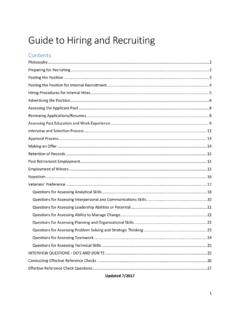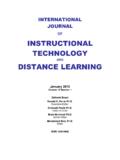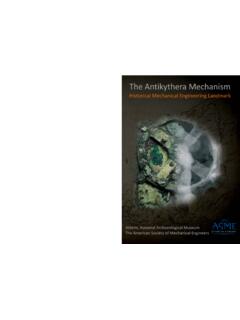Transcription of The Influence of Technology in Art Appreciation and Sales as …
1 THE Influence OF Technology IN ART Appreciation AND Sales AS A FACTOR IN THE SUSTAINABILITY OF THE RETAIL ART INDUSTRY Sarah Gamboa Mentor: Dr. Sharon Hanna-West Abstract This paper will cover many of the ways that Technology is affecting the retail art industry, both positive and negative, and come to a conclusion about the overall effect of Technology on art Appreciation and art Sales , and whether the industry will be sustainable in light of these influences. Themes discussed in this paper shall include the economic and sustainable effects of Technology on the art market. 2 Table of Contents 3 Role of Technology in Art .. 3 Triple Bottom Line Analysis .. 4 How People use Technology for Art .. 4 Environmental Impact .. 5 Accessibility .. 6 The Businesses of art .. 11 Promotion & Social Media .. 12 Security .. 13 Old Meets New .. 15 Technology Industry Challenges .. 16 Conclusion .. 16 References.
2 17 3 Sustainability The Brundtland Commission defined sustainable development as meeting the needs of the present generation without compromising the ability of future generations to meet their own needs (UNWCED, 1987). Sustainability is the ability to sustain action or life indefinitely. In a business context, many companies apply sustainability via a triple bottom line approach. The triple bottom line involves three bottom lines of focus: people, planet, and profits. A triple bottom line measures the company's degree of social responsibility (people), environmental responsibility (planet), and economic value (profits). Multitudes of real life business cases provide undeniable evidence that sustainable business practices lead to increased profitably in the long term. This paper will apply the triple bottom line approach to the retail art market and find what effects Technology has had on the overall sustainability of the market.
3 Role of Technology in Art Through the ages, Technology and art have been intrinsically linked. From the pyramids at Giza to St Peter s Basilica, from the most basic sketch to the grandest cathedral, humans build not only for function but also with an eye to form. Today, the word Technology evokes a very different meaning. It conjures images of whirling lights and bundles of wires rather than simple machines and hardworking carpenters. Similarly, the word art has also undergone a rebirth; it now evokes images of digital art as well as classical paintings and sculpture. Where architecture was perhaps the best example of this marriage of art and Technology , today computers are the new face of this union. Art and Technology are inexorably linked in that as one evolves, so does the other. This means not just changes in the way that art is created, but in the way that it is viewed, appreciated 4 and subsequently sold.
4 There are many ways that Technology has influenced the way that we appreciate and buy art. These ways have also impacted art retailers. This paper will cover many of the ways that Technology is affecting the retail art industry, both positive and negative, and come to a conclusion about the overall effect of Technology on art Appreciation and art Sales , and whether the industry will be sustainable in light of these influences. Triple Bottom Line Analysis How People use Technology for Art Technology has become a pervasive Influence in our society. It has especially influenced the way that we create and appreciate art. More artists are using Photoshop and digital cameras to create and edit pieces than ever before. Artists are also using computers to connect and gain inspiration from each other. Artists aren t the only ones using Technology in new and unexpected ways. The public, museums, and galleries are also using Technology in ways that would have seemed impossible as little as thirty years ago.
5 The public is using Technology to appreciate and become connected with art. Museums now keep online collections and host online walkthroughs of their facilities, as well as distribute special exhibit media online and market their events to internet audiences. Galleries not only advertise their events online but also sell some pieces through online Sales , discover new artists via the internet and preview an artist s collection online. Artists are able to independently market themselves, create a dedicated following for their work, and sell their pieces online without the benefit, or hindrance, of a middleman agent or gallery owner. Artists are also able to use Technology as a new medium with which to create art. Consumers are able to 5 discover many new artists and keep up to date on the latest and greatest accomplishments of their favorite artists. Environmental Impact When you analyze sustainability using the triple bottom line approach, you are concerned with three factors: people, planet, and profit.
6 This section shall focus on how Technology has made the art market more sustainable as concerns the planet. Technology has helped to reduce waste in the industry as a whole, and for individual artists. Because of Technology and the ability to share and send, traditionally printed media, digitally, less pamphlets and promotional materials are printed. There is also less waste on the part of the individual artist. Artists who use Technology are able to create sketches, edit photographs and preview design changes before creating a final product. This allows artists to use fewer materials in their creative process, thus reducing waste. Adobe has created a series of promotional videos, Make it with Creative Cloud, that demonstrates artists using Adobe s computer programs to edit, preview and test drive a design before printing or building a final product (Adobe, 2013). Technology has also made some art disciplines more sustainable.
7 In its early years, film and photography both required harsh chemicals to develop negatives and images revealed onto photo paper. The move to a digital medium has greatly reduced the amount of harsh chemicals that were being disposed of down darkroom sinks. Technology can also reduce the need for travel in the art industry. Previously, art dealers and gallery owners would travel to a client s home in order to assist in deciding which work of art would best suit the client s home and taste. These dealers often brought multiple works with them on these house calls. Today, apps like ArtMatch make it possible for clients to choose a 6 piece that they like, and then use their phone to visualize the artwork in their home. Digital photography and programs like Photoshop can also be used to remotely assist potential customers in deciding what pieces would look best in their homes, further reducing the need for travel.
8 Accessibility The economic impact Technology is having on art is perceived as both positive and negative. Technology is making art more accessible to the public, especially to those who do not necessarily understand art, or who cannot afford either the time or the money, to visit galleries or museums. There are various projects currently underway that help art reach the masses. These include the Google Art Project, , Amazon Art, Artsicle, and various phone applications. The Google Art project has worked with museums around the world in an effort to put great works of art at the fingertips of people who might otherwise never get to see the real thing up close (Sood, 2011). At its initial release, on February 1, 2011, over 1000 works of art by more than 400 artists were available for viewing. These images are in super high-resolution, which reveals brushstroke-level detail. This detail allows users to see works at an intimate level that they may not get to experience even if they did visit the works in person.
9 Through the Street View Technology , users are also able to take a virtual tour inside 17 of the world s most acclaimed art museums, including The Metropolitan Museum of art and MoMA in New York, The State Hermitage Museum in St. Petersburg, Tate Britain & The national Gallery in London, Museo Reina Sofia in Madrid, the Uffizi Gallery in Florence and Van Gogh Museum in Amsterdam (Sood, 2011). The program also lets users save specific views of any of the artworks and build [their] own personalized collection. Comments can be added to each painting 7 and the whole collection can then be shared with friends, family or on the web (Sood, 2011). On April 3, 2012 the project announced a major expansion which makes available sculpture, street art and photographs from 151 museums in 40 countries (Sood, 2012). The original Art Project counted 17 museums in nine countries and 1,000 images, almost all paintings from Western masters.
10 Today, the Art Project includes more than 30,000 high-resolution artworks, with Street View images for 46 museums, with more on the way (Sood, 2012). Clearly, this expansion signals that the public is interested in what the project offers and is clamoring for more, as are the museums and galleries who chose to partner with Google on this project. Google is not the only company trying to make art more accessible, is a website that allows its users to browse through images of thousands of different individual pieces, styles, and mediums of art and from those images, curate a selection of their favorite pieces. Artsy also provides biographies of the artists and features information about art shows at galleries and museums. Some of the works of art featured on are even for sale. Their mission is to make all the world s art accessible to anyone with an internet connection (Cleveland, ). Around 25,000 images of artworks are available to browse by genre, region, medium or style and prospective buyers can filter the artworks for sale by choosing a price range for their purchase.













